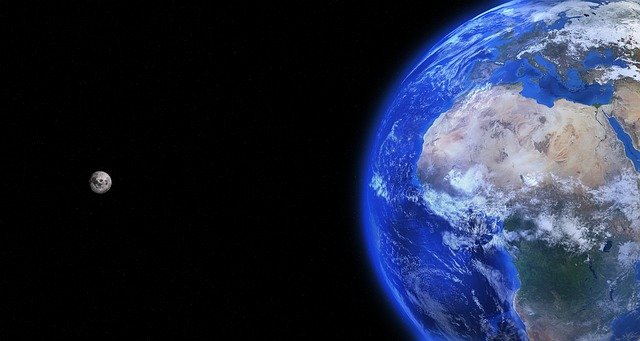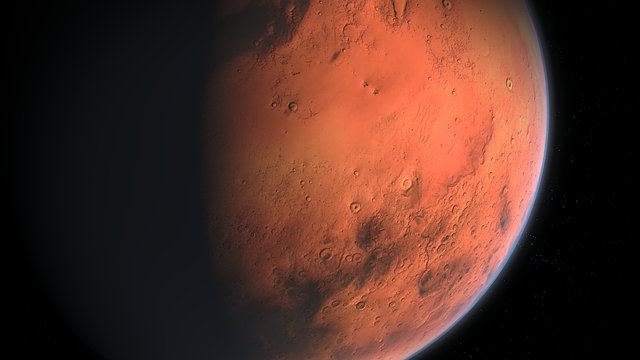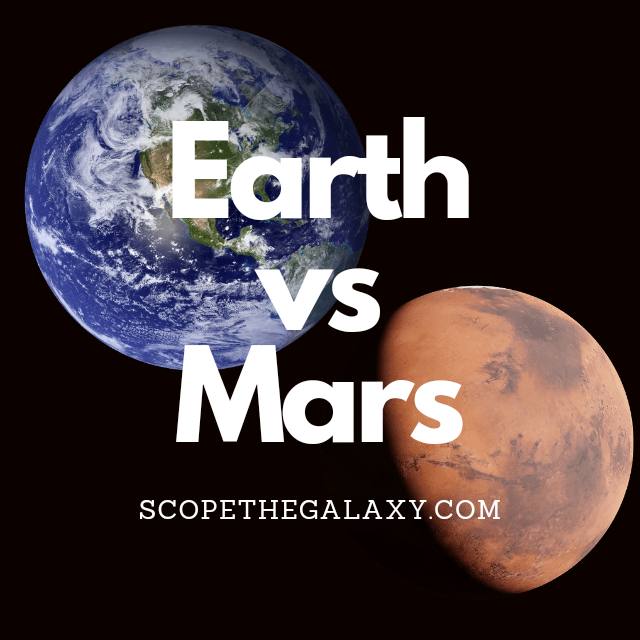*This post may contain affiliate links. This means we may make a commission if you purchase an item using one of our links*
The main differences between Earth and Mars is that Earth is bigger with a diameter of 12,724km whereas Mars is 6,779km, Mars has 2 Moons whilst the Earth has 1, Mars’ atmosphere is only 1% of Earth’s, Mars is the 4th farthest planet from the Sun whilst Earth is 3rd and unlike Mars Earth is the only known planet able to sustain intelligent life.
If you want to learn of the variety of other differences between Mars and Earth along with some of their similarities, continue reading as it’ll be covered in more detail in the remainder of this article.
What Is The Planet Earth?
Table of Contents

Our home planet Earth is the 3rd farthest planet from the Sun, made up of a mixture of water and solid rock like objects, and is the only entity in our solar system known to allow intelligent life forms like ourselves to exist.
Earth’s distance of 152 million km from the Sun has allowed it to remain within the goldilocks zone and as a result, the planet has been able to thrive for millions of years. It orbits the Sun in a circular pattern, much like all the other planets, has only one natural satellite which would be the Moon and is a terrestrial planet to boot.
In regards to its diameter, Earth is the 5th largest planet with a diameter 12,742km.
Earth’s temperature ranges based on the region you’re located where it can be from as low as -94 degrees Celsius in Antarctica to as high as 50 – 55 degrees Celsius in Tunisia.
As for the planets composition, it consists of the crust, the mantle, the outer core and the inner core, where the inner core is the hottest element within the Earth reaching temperature in excess of 5,200 degrees Celsius.
In regards to some of its most unique features, Earth is around 71% water, has an atmosphere consisting mostly of oxygen and nitrogen that is also made up of 5 main layers, with the highest to lowest being the troposphere, stratosphere, mesosphere, thermosphere and exosphere.
A day on Earth is 24 hours and an orbital cycle around the Sun takes 365 days to complete. It’s axial tilt is more distinct at 23.5 degrees to the right.
What Is The Planet Mars?

Mars, also known as the red planet, is the celestial object that’s the front runner in our entire solar system to become a possible new home for us if terraformed. It is also the 4th farthest planet from the Sun and is one of 4 main line terrestrial planets (not including Pluto) in our solar system.
This means that one year on Mars will take roughly 687 Earth days and a day on Mars is roughly the same as Earth at 24 hours and 37 minutes. It’s axial tilt is also very similar to that of Earth where it is positioned around 25 degrees to the right.
It may not be the largest terrestrial world in our solar system as its diameter is only 6,779km but, it does have the most moons amongst the normal terrestrial planet where two, namely Deimos and Phobos, are currently orbiting the red planet.
Like Earth and the other terrestrial worlds, Mars does have an atmosphere, certainly more visible than that on Mercury but, when compared to Earth’s it is merely 1% of its volume.
As a result it is more susceptible to larger debris striking its surface and is unable to trap in too much heat either. This is why it’s on the colder side with a temperature of around -65 degrees Celsius on average. On the contrary its core is significantly hotter at 1,350 degrees Celsius.
Mars is probably the most explored planet outside of our own, with a multitude of rovers like Sojourner (1997–1997), Opportunity (2004–2018), Spirit (2004–2010), Curiosity (2012–), and Perseverance (2021–) that have landed on the Martian soil to explore it.
Billionaires like Elon Musk and even Jeff Bezos are trying for an opportunity to genuinely have astronauts land on the Martian soil, possibly as early as 2029 so, Mars clearly has a lot interested in its terrain, as a potential substitute for Earth in the future.
Similarities Between Earth And Mars
The similarities between Mars and Earth include the following:
- Both have a hotter central core.
- Both are a spherical in shape.
- Both are terrestrial planets.
- Both have an atmosphere and a rocky surface.
- Both orbit the Sun in a circular pattern.
- Neither are tidally locked to the Sun.
- Both have no rings surrounding them.
- Both have a natural satellite orbiting them.
Differences Between Earth And Mars
As for the differences between the two, they include the following:
- Earth is 71% water and 29% rock whereas Mars is mostly rock although it is estimated that only 14% at most is water and the remainder is solid, dry rock.
- Earth has only 1 moon whilst Mars has 2.
- Mars is smaller with a diameter of 6,779km whereas Earth is nearly twice its length at 12,742km.
- In regards to mass Earth is also clearly bigger with mass of 5.972 × 10^24 kg compared to Mars’ much smaller mass of 6.39 × 10^23 kg.
- Earth is the only planet in our solar system with intelligent life whereas Mars has none as far as we know.
- Earth’s magnetic field is far stronger than Mars’ where it is said to be 40 times stronger.
- Mars has a weaker gravity also where it is 3.721 m/s² whereas Earth’s is 9.807 m/s².
- Earth’s weather varies depending on the region from as low as -94 to 55 degrees Celsius with the average numbers around 10 degrees Celsius whereas Mars is typically far cooler on average with temperatures of -65 degrees Celsius.
- Earth has a hotter core too where it is 5,200 degrees Celsius whereas the core within Mars is 1,350 degrees Celsius.
- Earth has an atmosphere that is significantly thicker than Mars’ where Mars’ is merely 1% the volume of Earth’s.
- Earth is the denser of the two where it is 5.514 g/cm3 compared to Mars’ 3.93 g/cm3.
- A day on Earth takes 24 hours whilst a day on Mars is a little longer at 24 hours and 37 minutes.
- It takes 365 days to orbit whereas Mars does so in 687 days.
- Mars has an axial tilt of 25 degrees compared to Earth’s 23.5 degrees.
- Earth is a blue and green color in terms of its general tinge whereas Mars is red in color.
Summary
Earth and Mars are closely related in a number of ways, whether it be there terrestrial structure, the length of the day, similar axial tilts and so on. However, the main reason both differ is because Earth is able to support intelligent life whereas Mars cannot.
Mars is the only planet right now that is being looked into for terraforming and maybe once this does happen the two will have a lot more in common but for now, they differ significantly from each other.

